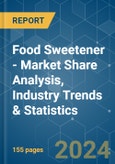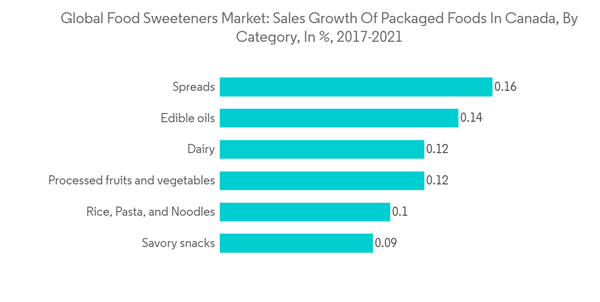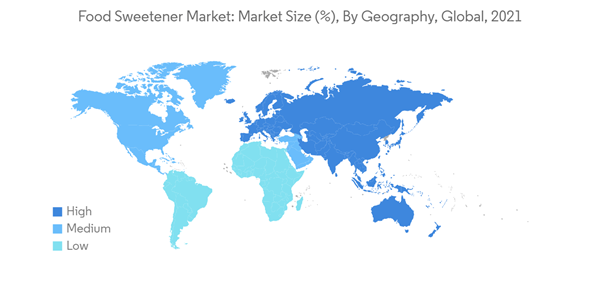The Food Sweetener Market size is estimated at USD 89.87 billion in 2024, and is expected to reach USD 101.53 billion by 2029, growing at a CAGR of 2.47% during the forecast period (2024-2029).
A fast-paced lifestyle and an increased preference for convenience food are expected to be some of the major drivers for the food processing industry. Furthermore, increased consumption of soft drinks, especially carbonated soft drinks, is expected to drive the demand for sweeteners in the U.S. The changing consumer preference drives the demand for healthier and safer food products with high nutritional value. The consumption of sugar substitutes, such as xylitol, erythritol, and mannitol, is rapidly increasing worldwide, attributed to consumer awareness, government regulations to reduce sugar consumption, and their application in many health and wellness food products in the market.
Increasing concerns regarding the prevalence of obesity are encouraging consumers to opt for natural and zero-calorie sweeteners, such as stevia. According to the Global Stevia Institute's internal survey, approximately 60% of Americans prefer low-calorie sugar in their foods.
The inclination toward low-calorie beverages, such as diet coke and low-calorie drinks, and low-calorie foods, such as yogurt, ice cream, and grain-based desserts, has gained popularity worldwide. The physiology of sweetness receptors is also being studied in greater detail to make food and beverages sweet without using sugar. Also, with the changing regulatory environment and permission for using sweeteners in dairy products, biscuits, and confectionery, the artificial sweeteners segment is witnessing high growth.
The demand for food sweeteners around the world is being driven in large part by consumers' growing health consciousness. Additionally, the industry is expanding due to consumers' growing preference for natural products. Additionally, the fast food, bakery, and consumer lifestyle and eating habits are driving the market for these industries, which has resulted in the market experiencing considerable development throughout the projected period. Also, the worldwide use of sugar substitutes like xylitol, erythritol, and mannitol is rising quickly, thanks in part to consumer awareness campaigns, laws requiring less sugar intake, and their inclusion in a variety of marketable health and wellness food items.
This product will be delivered within 2 business days.
A fast-paced lifestyle and an increased preference for convenience food are expected to be some of the major drivers for the food processing industry. Furthermore, increased consumption of soft drinks, especially carbonated soft drinks, is expected to drive the demand for sweeteners in the U.S. The changing consumer preference drives the demand for healthier and safer food products with high nutritional value. The consumption of sugar substitutes, such as xylitol, erythritol, and mannitol, is rapidly increasing worldwide, attributed to consumer awareness, government regulations to reduce sugar consumption, and their application in many health and wellness food products in the market.
Increasing concerns regarding the prevalence of obesity are encouraging consumers to opt for natural and zero-calorie sweeteners, such as stevia. According to the Global Stevia Institute's internal survey, approximately 60% of Americans prefer low-calorie sugar in their foods.
The inclination toward low-calorie beverages, such as diet coke and low-calorie drinks, and low-calorie foods, such as yogurt, ice cream, and grain-based desserts, has gained popularity worldwide. The physiology of sweetness receptors is also being studied in greater detail to make food and beverages sweet without using sugar. Also, with the changing regulatory environment and permission for using sweeteners in dairy products, biscuits, and confectionery, the artificial sweeteners segment is witnessing high growth.
Food Sweetener Market Trends
Shift Toward Convenience and Processed Food Consumption
The increasing demand for convenience and processed foods, such as sweet/sugar-based ready-to-eat foods, ready-to-drink beverages, snacks, and frozen meals, is one of the significant factors driving the growth of the high-fructose corn syrup market. Due to the rising urbanization, growing middle-class population, an increasing number of working women, and rising disposable income, the developed and developing regions across the world are witnessing a rising demand for processed and packaged food, which may increase the need for food packaging and sugar processing solutions, driving the demand for high-fructose corn syrup in food and beverage applications across the world. In addition to its sweetening properties, HFCS keeps foods fresh, lowers the freezing point, retains moisture in bran cereals and breakfast bars, enhances fruit and spice flavors, promotes surface browning, and provides fermentability. Overall, the huge demand for food has led the entire value chain to open the markets for HFCS globally, along with new introductions from foreign players.The demand for food sweeteners around the world is being driven in large part by consumers' growing health consciousness. Additionally, the industry is expanding due to consumers' growing preference for natural products. Additionally, the fast food, bakery, and consumer lifestyle and eating habits are driving the market for these industries, which has resulted in the market experiencing considerable development throughout the projected period. Also, the worldwide use of sugar substitutes like xylitol, erythritol, and mannitol is rising quickly, thanks in part to consumer awareness campaigns, laws requiring less sugar intake, and their inclusion in a variety of marketable health and wellness food items.
Asia Pacific Dominates the Market
China is one of the world's largest producers of sweeteners, dominating the global market for many high-intensity sweeteners, such as saccharin, cyclamate, acesulfame-K (Ace-K), stevia, aspartame, sucralose, glycyrrhizin, alitame, and neotame. Also, the consumption of sweeteners is rising rapidly in China due to the increasing demand for sugar-enriched food and beverage products. Moreover, with the growing economic importance of stevia in the country, players are focusing more on this market. Stevia producer PureCircle is seeking to ramp up production for the Chinese market after receiving a patent for its stevia Reb M sweetener in the country. Further, the increasing demand for natural and healthful alternatives in the region has grabbed the attention of many food and beverage giants in Asia. For example, Coca-Cola and Pepsi's market shares have drastically declined due to the use of aspartame. Bearing this in mind, they have expanded their product ranges with natural plant-based stevia. Therefore, increased demand for natural, non-caloric sweeteners, and high demand for sweeteners in various applications, such as processed food and beverages from emerging economies in Asia, are the major factors driving the market's growth.Food Sweetener Industry Overview
Cargill Inc., Tate & Lyle PLC, Archer Daniels Midland Company, Ingredion, and DuPont de Nemours currently dominate the food sweetener market. Inc., Sudzucker, and AB Sugar. Players like Cargill, Archer Daniels Midland Company, and Tate & Lyle have a strong foothold in the market due to strong loyalty in emerging countries. Acquisitions and new product launches are the most preferred growth strategies. Leading companies are focusing on expansions and partnerships. The market leaders focus on launching innovative, low-calorie, and natural ingredient-based products. Huge investments have been made in R&D to develop products for specific needs.Additional Benefits:
- The market estimate (ME) sheet in Excel format
- 3 months of analyst support
This product will be delivered within 2 business days.
Table of Contents
1 INTRODUCTION
4 MARKET DYNAMICS
5 MARKET SEGMENTATION
6 COMPETITIVE LANDSCAPE
Companies Mentioned (Partial List)
A selection of companies mentioned in this report includes, but is not limited to:
- Tate & Lyle PLC
- Cargill Incorporated
- Archer Daniels Midland Company
- DuPont de Nemours Inc.
- Ingredion Incorporated
- Ajinomoto Co. Inc.
- NutraSweet Company
- GLG Life Tech Corporation
- Tereos SA
- Foodchem International Corporation
Methodology

LOADING...










